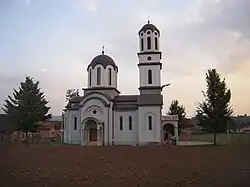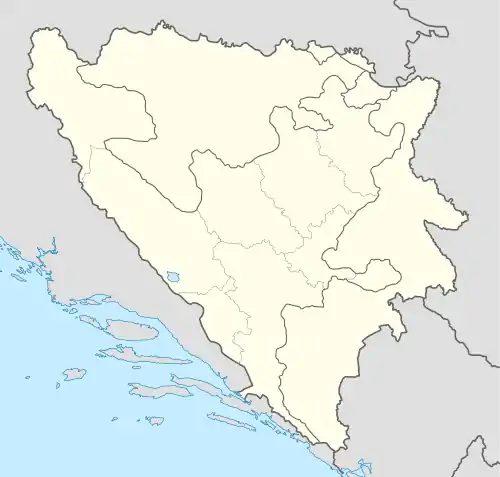Kuljani
Kuljani (Serbian Cyrillic: Куљани) is a village in the municipality of Banja Luka, Republika Srpska, Bosnia and Herzegovina.[2] It lies about 10 km north from the city on the left side of the river Vrbas.
Kuljani
| |
|---|---|
 | |
 Kuljani | |
| Coordinates: 44°50′50″N 17°11′52″E | |
| Country | |
| Entity | |
| Municipality | Banja Luka |
| Population (2013) | |
| • Total | 4,294[1] |
| Time zone | UTC+1 (CET) |
| • Summer (DST) | UTC+2 (CEST) |
| Area code | +387 51 |
History
This settlement was known for its catholic population through the last few centuries. Most of the population moved to Croatia during the last civil war in Yugoslavia (1992-1995). After the war this small village started to expand. A large number of new residents were Serbian refugees who found a new place for living after they had lost their old homes during the war. The village began to grow and soon became a suburban part of Banja Luka City.
Public infrastructure
The road infrastructure is still in very bad shape since there is no budget investment planned. As of 2010, there is a post office in operation and a medical ambulance is in planning to be opened. The old public school is also still operational.
Population
| National census | 1991 | 1981 | 1971 |
| Croats | 773 (64,04%) | 760 (68,03%) | 736 (85,28%) |
| Serbs | 283 (23,44%) | 222 (19,87%) | 93 (10,77%) |
| Muslim[3] | 3 (0,24%) | 0 | 0 |
| Yugoslavs | 73 (6,04%) | 101 (9,04%) | 0 |
| rest and unknown | 75 (6,21%) | 34 (3,04%) | 34 (3,93%) |
| Altogether | 1.207 | 1.117 | 863 |
In 2008 the maximal estimated population counted 3,742.[4] There is also a small group of Slovenians in the village.
Trivia
A local proverb goes Culjani - selo ljepše od Pariza (Kuljani - this village is more beautiful than Paris)[5]
Notes and references
- Nataša Gojković; Ognjen Ignjić. Census of Population, Households and Dwellings in BH 2013 Republika Srpska Preliminary Results (PDF) (Report). Republika Srpska Institute of Statistics, Banja Luka.
- Official results from the book: Ethnic composition of Bosnia-Herzegovina population, by municipalities and settlements, 1991. census, Zavod za statistiku Bosne i Hercegovine - Bilten no.234, Sarajevo 1991.
- Muslims are today known as Bosniaks.
- Урбанистички завод Републике Српске, УРБАНИСТИЧКИ ПЛАН БАЊАЛУКЕ 2008-2020 (PDF) (in Serbian). May 2009.
- Aleksandar Đurić, ca. 1998.